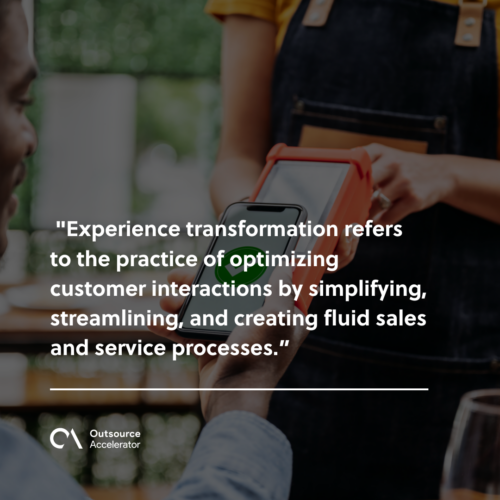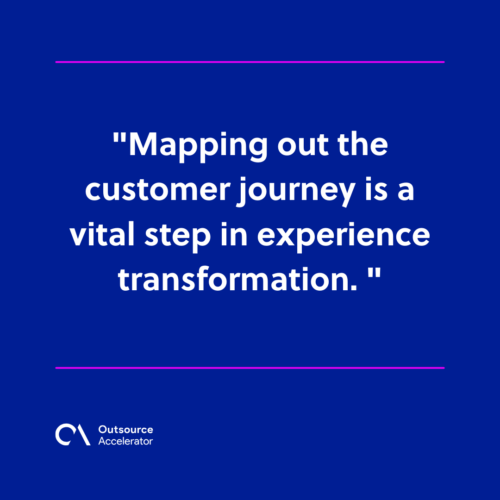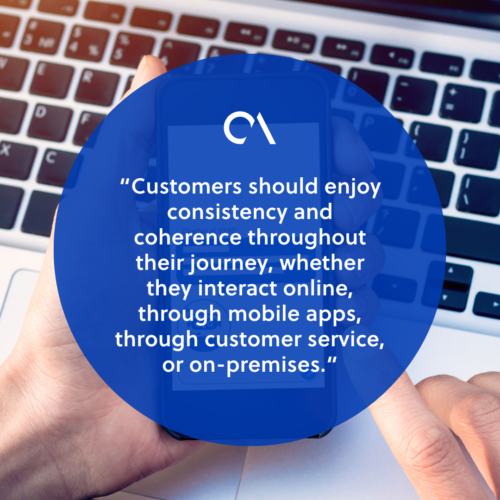Experience transformation: What you need to know

When asked why people stay with a particular brand, “customer experience” is likely to crop up as a common answer.
Ensuring the customer feels satisfied throughout the journey is a necessary strategy.
As a result, the concept of experience transformation has emerged for those companies looking to differentiate themselves and build long-term customer loyalty.
Experience transformation delves into the very essence of interactions, seeking to elevate them into unforgettable moments.
This article explores the holistic approach of experience transformation and how businesses can adapt it to fit their customer service model.
What is experience transformation?
Experience transformation refers to the practice of optimizing customer interactions by simplifying, streamlining, and creating fluid sales and service processes. It’s also called customer experience (CX) or employee experience (EX) transformation.
Experience transformation seeks to create memorable interactions across all touchpoints. This markedly makes it different from traditional approaches that focus solely on delivering functional products and services.
It involves a deep understanding of user needs, preferences, and pain points to design experiences that span digital and physical realms.
With this approach, organizations invest in technologies, processes, and cultural shifts to foster lasting connections that set them apart in the market.

Breaking down the experience transformation framework
To successfully implement experience transformation, businesses need a clear framework to guide their efforts and ensure a systematic approach.
Let’s break down the key components of the experience transformation framework:
Customer-centricity
At the core of experience transformation is a deep understanding of the target customers. It involves discerning their needs, expectations, and behaviors across different touchpoints.
Data analytics and feedback mechanisms play a crucial role in this phase. The information gathered serves as a foundation for designing personalized and tailored experiences that resonate on a deeper level.
Journey mapping
Mapping out the customer journey is a vital step in experience transformation. It involves visualizing each touchpoint and interaction a customer has with the company across different channels and stages.
By identifying gaps, bottlenecks, and moments of frustration or delight, businesses can optimize the journey.

Technology integration
Technology acts as a catalyst for experience transformation as it enables businesses to deliver efficient and convenient experiences.
Some frequently used tools include:
- Customer relationship management (CRM) systems
- Data analytics tools
- Artificial intelligence
The integration of emerging technologies is not just a trend but a necessity for creating modern and responsive experiences.
Employee engagement
A key aspect of a successful experience transformation is ensuring that employees are aligned with and committed to the company’s vision. Engaged and empowered employees contribute significantly to a positive customer experience.
As employees become brand ambassadors, their satisfaction directly influences the quality of customer interactions.
Continuous iteration and feedback loops
Experience transformation is an ongoing process that requires constant monitoring, analysis, and refinement.
Feedback loops and an iterative approach allow organizations to adapt to changing preferences, market dynamics, and technological advancements. This ensures the experience remains relevant and impactful.
Benefits of experience transformation
Experience transformation brings several benefits to businesses, positively impacting both customers and the organization itself.
Enhanced customer satisfaction
When customers encounter seamless interactions, their overall satisfaction levels rise. This positive sentiment leads to other benefits, such as loyalty and word-of-mouth referrals.
With the help of automation and personalization, service providers such as Acquire BPO are experts of experience transformation. Their services enhances customer journey through streamlining processes and providing quick solutions, leading to increased satisfaction.
Increased customer loyalty and retention
Exceptional experiences foster strong emotional connections. Customers who have positive experiences are more likely to remain loyal, engage in repeat business, and become brand advocates.
Competitive edge
In markets saturated with similar products and services, experience becomes a key differentiator.
Companies that invest in experience transformation stand out from the competition and are better positioned for long-term success.
Improved brand perception
Remarkable experiences contribute to a strong brand reputation and perception. A well-crafted experience transformation strategy enhances brand image, making it more favorable in the eyes of customers.
Revenue and profitability
Satisfied customers tend to spend more, increasing revenue. Additionally, the cost of serving loyal customers is lower than acquiring new customers, leading to improved profitability.
Internal process optimization
Streamlining and integrating various aspects of the customer journey often result in more efficient business operations.
Optimized processes mean cost savings and improved resource allocation.
How to incorporate experience transformation into business
Here are some tips to guide the process of integrating experience transformation into your business.
Define clear objectives and metrics
Begin by establishing clear objectives for the experience transformation initiative. Identify the desired outcomes, whether it’s:
- Improving customer satisfaction
- Increasing loyalty
- Differentiating the brand
Define measurable metrics that will gauge the transformation’s success.
Understand customer needs
Conduct in-depth research to understand your customers. Develop customer personas and map their journeys to identify critical touchpoints.
This understanding is crucial to designing your experience transformation strategy.
Create personalized experiences
Utilize the data collected to create personalized experiences for customers. Tailored approaches enhance customer satisfaction and loyalty.
This can be done through strategies like:
- Targeted marketing
- Personalized recommendations
- Customized interactions
Collaborate cross-functionally
Experience transformation involves collaboration across different departments and functions within the organization.
Foster cooperation among teams to ensure alignment and a unified approach toward delivering outstanding customer experiences.
Implement omnichannel integration
Break down silos between different channels and touchpoints to create a seamless and integrated experience.
Customers should enjoy consistency and coherence throughout their journey, whether they interact online, through mobile apps, through customer service, or on-premises.

Empower your employees
Invest in employee training programs that focus on customer service, empathy, and problem-solving. Encourage front-line employees to make choices that will benefit the client.
Constantly provide them with the tools and knowledge to deliver exceptional service.
Measure impact
Regularly assess the impact of the experience transformation initiative against predefined metrics. Communicate successes to internal stakeholders and, if applicable, to customers.
Positive reinforcement and transparent communication help maintain momentum and support for ongoing efforts.
Remember that experiencing transformation is an ongoing journey. Be agile and flexible in your approach to create a culture where customers always feel welcome.







 Independent
Independent




